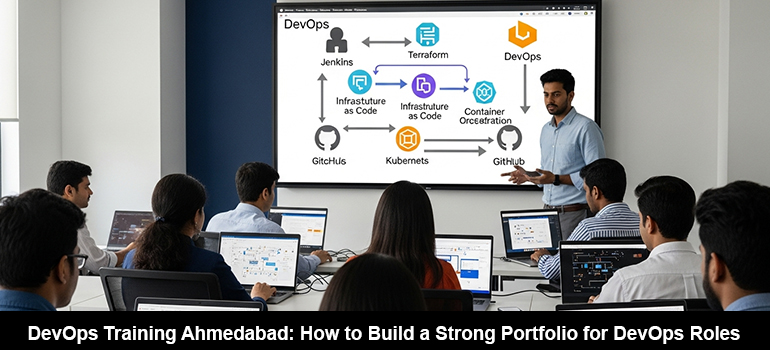
In the fast-paced world of technology, landing a top DevOps role is highly competitive. While completing a training course is an essential first step, employers are looking for more than just a certificate. They want tangible proof that you can apply your knowledge in a real-world setting. This is where a strong DevOps portfolio comes in. It’s your personal showcase of projects, pipelines, and problem-solving skills that makes you stand out from other candidates. This will teach you how to construct one.
1. Start with a Strong CI/CD Foundation
Your portfolio’s first project should demonstrate your understanding of the core DevOps lifecycle. After completing a DevOps Training Ahmedabad program, you should have the foundational knowledge to build a complete CI/CD (Continuous Integration/Continuous Deployment) pipeline. Start with a simple web application (like a Python, Node.js, or Java app). Host the code on GitHub, then use a tool like Jenkins or GitLab CI to automatically build, test (using unit tests), and deploy the application to a simple server or staging environment. This one project proves you understand version control, automation, and the feedback loop.
2. Showcase Your Cloud & Security Expertise
Modern DevOps is cloud-native, and security is everyone’s responsibility. This is why skills from an AWS Security Training Ahmedabad course are so valuable. Elevate your portfolio by taking that same web application and deploying it securely on AWS. Don’t just manually create an EC2 instance. Instead, use Infrastructure as Code (IaC) tools like Terraform or AWS Cloud Formation to define and manage your cloud resources. Show that you can configure a secure VPC (Virtual Private Cloud), apply a-proper IAM (Identity and Access Management) roles, and use security groups to lock down access. This demonstrates you can build environments that are not only functional but also secure and repeatable.
3. Integrate Containerization
To show you are up-to-date with current industry standards, you must include containerization. Any quality Docker Training Ahmedabad course will provide the basics, but your portfolio is where you show mastery. Take your application and write a clean, efficient, multi-stage Dockerfile for it. Use Docker Compose to manage your application and its dependencies (like a database) for local development. The final step is to push your Docker image to a container registry (like Docker Hub or AWS ECR) and deploy it to a container orchestration service like Amazon ECS or, for a more advanced project, Kubernetes (EKS). This shows recruiters you can build scalable, portable, and efficient applications.
4. Put It All Together
Your GitHub profile is your portfolio. Ensure every project repository has a detailed README.md file. This file should explain:
- What the project is.
- The architecture (a simple diagram is a huge plus).
- The tools and technologies used.
- Detailed instructions for establishing and managing the project.
You can also add monitoring tools like Prometheus or Grafana to your deployed applications to show you understand the full DevOps lifecycle, including operations and observability.
Conclusion
A certificate gets you an interview, but a strong portfolio gets you the job. It’s the practical evidence that turns your theoretical knowledge into proven ability. Building these projects takes dedication, but each one makes you a more confident and capable engineer. At Highsky IT Solutions, we believe in this practical-first approach, ensuring our students are not just certified, but truly job-ready. Start building your portfolio today, and take the next big step in your DevOps career.
Read Only: –Career In AWS and DevOps- A Complete Guide What to Choose



